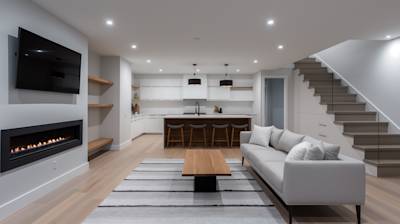Replace One Hardwood Plank
Estimating the Average Cost to Replace One Hardwood Plank
Hardwood floors add elegance and value to any home, but over time, they may experience wear and tear or sustain damage. If you have a single plank in your hardwood floor that needs replacement, you might be wondering about the cost involved. The average cost to replace one hardwood plank can vary depending on various factors such as the type of wood, the size of the plank, and the extent of the damage.
When estimating the cost, it's essential to consider the price of the replacement plank itself, which can range from $5 to $15 per square foot. Additionally, you need to account for the labor costs associated with removing the damaged plank, preparing the area, and installing the new plank. Typically, professional flooring contractors in Seattle charge an average of $50 to $100 per hour for their services.
It's crucial to note that the overall cost may also include additional expenses such as adhesive, nails, and finishing materials. To get an accurate estimate for your specific situation, it's recommended to contact a professional flooring contractor in Seattle for a detailed quote.
From Start to Finish: Step-by-Step Guide for Replacing a Single Hardwood Plank
Replacing a single plank in a hardwood floor may seem like a daunting task, but with the right tools and knowledge, it is possible to achieve a seamless repair. Here is a step-by-step guide to help you through the process:
Tools Needed:
- Carpenter's square
- 1/2- or 3/8-inch-diameter spade bit
- Power drill
- Wood chisel
- Hammer and nail set
- Nail puller
- Replacement hardwood plank
- Construction adhesive
- Scrap piece of wood
- 2-inch-long ring-shank flooring nails
Step 1: Preparation
If there are any nails in the damaged board, use a hammer and nail set to drive them as far through the board as possible. This step ensures a smooth removal process without damaging the surrounding area.
Step 2: Marking and Drilling
Use a carpenter's square to mark a perpendicular line across the section of the board to be removed. If you're replacing the entire strip, skip this step. Next, use a 1/2- or 3/8-inch-diameter spade bit and a power drill to drill holes along the marks. These holes will make it easier to split and remove the damaged board.
Step 3: Splitting and Removal
Using a wood chisel, carefully split the damaged board into two pieces. This technique facilitates the removal process. Pry out the damaged board or strip, ensuring you remove any additional boards in the same manner, staggering the end joints.
Step 4: Prepare the Replacement Plank
Cut a replacement strip to the same length as the one you removed. To install the replacement strip, cut off the bottom side of the groove on the board. Removing the bottom groove allows you to insert the board between two others by placing its tongue side first and then lowering its groove side into place.
Step 5: Test-fit and Installation
Test-fit the replacement strip to ensure it fits properly. If needed, make any adjustments by recutting the board. Once satisfied with the fit, remove the strip and apply construction adhesive to the backside. Install the strip and gently tap it into place, using a scrap piece of wood to protect its surface. Nail the board with 2-inch-long ring-shank flooring nails, driving the heads just below the surface with a nail set.
Following these steps will help you successfully replace a single plank of hardwood flooring, restoring the beauty and functionality of your floor.
Expert Advice on Replacing a Single Hardwood Plank
When it comes to replacing a single plank of hardwood flooring, seeking expert advice can save you time, effort, and potential mistakes. Here are some valuable tips from professional flooring contractors in Seattle:
Take your time: Rushing through the process can lead to errors and unsatisfactory results. Ensure you have all the necessary tools and materials before starting the repair.
Measure twice, cut once: Accurate measurements are crucial to achieve a seamless fit. Double-check your measurements before cutting the replacement plank to avoid unnecessary waste.
Protect the surrounding area: Use masking tape or a protective barrier to shield the adjacent boards from damage during the removal and installation process.
Seek professional assistance if needed: While replacing a single plank is a manageable task for some, more complex repairs may require the expertise of a professional flooring contractor in Seattle. They can ensure the job is done efficiently and with excellent craftsmanship.
By following these expert tips, you can navigate the process of replacing a single plank with confidence, achieving outstanding results.
At Seattle Renovation Group, we specialize in expert Seattle flooring installation and offer professional flooring contractor services in Seattle and the surrounding areas. Whether you need assistance with a single plank replacement or a complete hardwood floor installation, our experienced team is here to help.
Contact Seattle Renovation Group today to discuss your flooring needs and receive a personalized quote tailored to your project requirements.
Tags: Replace One Plank of Hardwood,



























